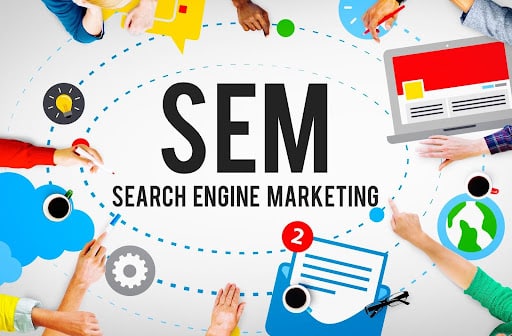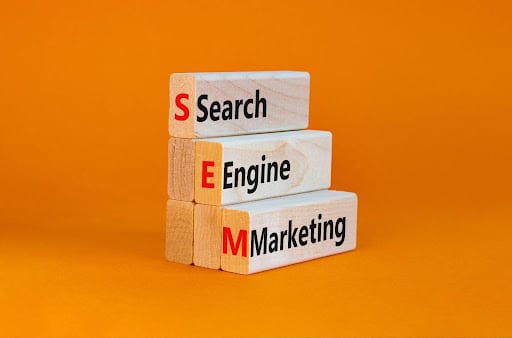Businesses can no longer afford to overlook the immense potential of Search Engine Marketing (SEM). A staggering eighty-seven percent of shoppers now initiate their product searches online, marking a seismic shift in consumer behavior. This shift has elevated the importance of Search Engine Marketing (SEM) as an indispensable marketing strategy in the ever-evolving digital marketplace.

But even with the importance of SEM becoming more and more evident, you might still be asking yourself, “Is SEM a good fit for my particular business?”
At the heart of SEM lies the power to enhance visibility and expedite growth. It’s an intricate web of methods designed to position your business at the forefront of consumer consciousness.
As you navigate the labyrinth of digital marketing strategies, you will be able to identify how SEM aligns with your business objectives and the different ways to effectively incorporate it into your marketing strategy. It demands a blend of finesse and analytical prowess to yield a Return On Investment (ROI) deserving of your endeavors.
Allow this comprehensive blog to serve as your ultimate resource for acquiring expertise in search engine marketing and unlocking its potential to propel your business to new heights. Let’s start with a deeper dive into what search engine marketing is, how it compares to other approaches, and the steps to take for your own SEM journey.
Understanding search engine marketing
At its core, search engine marketing is a potent vessel for amplifying brand visibility. It marries the art of advertisement with the science of algorithm-driven search platforms, crafting a robust strategy for entrepreneurs.
Envision SEM as a dynamic tapestry weaved with Pay-Per-Click (PPC) advertisements alongside organic Search Engine Optimization (SEO) efforts, each thread vital to the tapestry’s overall strength and vibrancy. Applying skillful SEM tactics propels your brand to the forefront of consumer consciousness.
The terms “pay-per-click” and “search engine optimization” might seem overwhelming, but they translate into substantial growth in a highly competitive marketplace.
The fundamentals explained
SEM propels businesses into the digital spotlight, leveraging paid ads to secure prominent placement on Search Engine Results Pages (SERPs). Precise targeting ensures visibility to the right audience.
An adept SEM strategy interweaves the immediacy of pay-per-click with the sustained growth facilitated by SEO. This dual approach maximizes both short and long-term online presence.
How does search engine marketing differ from search engine optimization?
Search engine marketing and search engine optimization are two distinct strategies used to improve a website’s visibility and drive traffic from search engines. While they both aim to increase a website’s overall visibility, they do so in different ways.
SEM refers to paid advertising efforts, where advertisers bid on keywords to display their ads in SERPs. These ads typically appear at the top or bottom of the SERPs, marked as “sponsored” or “ad.” SEM allows businesses to quickly gain visibility and reach their target audience by paying for ad placements.
On the other hand, search engine optimization is the process of optimizing a website to improve its organic (unpaid) search engine rankings. SEO relies on techniques such as keyword research, on-page optimization, link building, and content creation to enhance a website’s visibility and relevancy.
Unlike SEM, SEO strategies do not involve paying for ad placements but aim to achieve higher organic rankings by adhering to search engine guidelines and user preferences.
Search engine marketing focuses on paid advertising to gain immediate visibility, while search engine optimization aims to improve organic rankings over time by optimizing a website’s content and structure. Both SEM and SEO are valuable strategies that complement each other in driving targeted traffic to a website.
Every click in SEM is a potential revenue opportunity, turning searchers into valuable customers.
Mastery of SEM involves balancing budgetary constraints with aggressive marketing goals. By harnessing data analytics, businesses fine-tune campaigns for optimal performance, driving quality traffic that translates to tangible business growth. Implementing SEM correctly revolutionizes your digital footprint.
SEM vs. SEO: the showdown
In the digital arena, SEM and SEO are both gladiators, but they battle with different weapons.
- SEM operates through paid advertisements, giving you immediate visibility on search engines — a quick strike tactic.
- SEO relies on organic search strategies, enhancing website content and structure for gradual and sustained online conquest.
- SEM results are instant, often yielding visibility as soon as campaigns go live, while for SEO, ranking improvements require more time.
- SEO offers credibility, as users often trust organic results more than ads, and it leads to long-term website traffic increases without continuous spending.
- SEM is clearly measurable, with the ability to track clicks and conversions meticulously, allowing for precise optimization and budget control.
- SEO is cost-effective in the long run, as it doesn’t rely on an ongoing budget for ads, and strong organic rankings reduce the cost per acquisition. While SEM brings the cavalry for an immediate show of strength, SEO builds the fortress for enduring visibility.
SEM and SEO are not adversaries; together, they form an unbeatable alliance in the quest for online dominance.
Assessing SEM’s value proposition

Delving into the realm of SEM demands a nuanced understanding of its strategic advantages and investment implications. Through SEM, businesses gain the lever to catapult their brand to the forefront of consumer consciousness with swift precision.
However, this digital alchemy comes at a cost — financial outlay must be meticulously weighed against potential ROI. A judicious assessment of SEM involves a thorough cost-benefit analysis, ensuring that the expenditure aligns with your business objectives and market position.
With SEM, you’re not simply casting a net; you’re spearheading a targeted expedition for immediate customer engagement and conversion.
Cost-benefit analysis for businesses
Determining the value of SEM requires a meticulous evaluation of costs versus potential returns.
- Initial investment: Consider the upfront costs associated with launching an SEM campaign, including keyword research tools, ad platforms, and professional services.
- Ongoing expenses: Factor in the recurrent costs, such as bid amounts for pay-per-click, campaign optimization, and management fees.
- Return on investment: Assess projected increases in traffic, conversion rates, and the resultant revenue against the SEM spend.
- Opportunity costs: Analyze whether alternative marketing strategies could yield more favorable outcomes with the same or lower investment.
- Competitive edge: Gauge the extent to which SEM differentiates your brand in a crowded marketplace and attracts your target demographic. Align SEM investments with clear, attainable business objectives.
The strategic deployment of SEM redefines market presence, but it must be underpinned by financial prudence and precise targeting.
SEM vs. other marketing approaches
As mentioned earlier, a significant difference between SEM and SEO is SEM offers immediate visibility, whereas SEO requires time to yield organic results.
Since 2016, with social media marketing ascending, businesses have balanced SEM with more personal, brand-centric campaigns.
Yet, it’s imperative to realize that SEM’s cost-effectiveness is a critical consideration in the face of content-driven approaches.
Through a judicious mix of SEM and content marketing, businesses leverage paid immediacy with an enduring, organic presence.
Conclusively, optimizing within SEM’s parameters ensures a nimble, measurable marketing endeavor.
Strategic implementation of SEM
When considering SEM, the precise alignment of keyword selection, ad copy, and targeting parameters forms the backbone of a campaign. Only by delving into the granular specifics will a business ascend within the digital marketplace.
The rigor of continual optimization ensures SEM campaigns remain relevant and agile, navigating the shifting sands of consumer trends and search engine algorithms, thereby securing a competitive vantage point.
Best practices for success
Establish your objectives with clarity and precision
A thorough understanding of your target market gives direction to your SEM endeavors. Begin by defining specific and measurable goals that align with your business’s core objectives, whether it be enhancing brand visibility, generating leads, or driving sales. Accurate, quantifiable goals are the compass by which companies chart success and refine strategies.
Select keywords judiciously, for they wield great influence
Investigate the search terms your audience is using to find services or products akin to yours. Distinguish between broad and narrow query phrases, recognizing that long-tail keywords often convert at a higher rate due to their specificity and user intent. A balance tailored to your campaign goals will anchor your SEM’s efficacy.
Craft compelling ad copy to captivate and convert
Your advertisement should resonate with the searcher’s quest — be it a solution, a product, or information. Emphasize benefits, articulate unique selling propositions, and leverage a clear call-to-action. Engage with relevance and precise language that speaks directly to the queries to present opportunities for connection and conversion.
Leverage analytics to guide and refine your campaigns continuously
Data is a veritable beacon, illuminating the pathways to enhanced performance and informed decision-making. Analyze metrics such as click-through rates, conversion rates, and cost-per-acquisition to discern the health and potency of your campaigns. These insights enable the agile adjustment of strategies, ensuring you remain at the forefront of SEM innovation and effectiveness.
Stay abreast of evolving trends and search engine updates
The digital landscape is perpetually in flux; thus, vigilance is crucial to maintain SEM strides. Educate yourself on the latest algorithm updates and search trends to preemptively adapt your strategies. In the dynamic year of 2024, those who best interpret and integrate these continual evolutions will find themselves positioned advantageously within the competitive expanse of search marketing.
Common pitfalls to avoid
Diving headlong into search engine marketing without a strategic plan is akin to navigating treacherous waters without a compass. Establish clear objectives, a structured approach, and a keen insight into the target audience before embarking.
Neglecting keyword research significantly undermines a campaign’s potential. Keywords are the lifeblood of SEM endeavors.
Without meticulous budget management, costs spiral out of control, undermining the financial stability of your campaign, which could lead to premature cessation and lost opportunities.
Improving SEM with quality landing pages
An underdeveloped landing page is a web page that lacks the necessary elements and optimization to effectively convert visitors into customers. This manifests in various ways, such as poor user experience, unclear call-to-action, slow loading times, or irrelevant content.
The problem with an underdeveloped landing page is that it hinders the conversion process. When visitors encounter a subpar user experience or struggle to understand what action they should take, they are more likely to abandon the page without completing the desired action, such as making a purchase or filling out a form. This not only wastes your budget and efforts but also prevents you from capitalizing on the potential conversions that your page could have generated.
On the other hand, a quality landing page plays a crucial role in both SEM and SEO strategies. From an SEM perspective, a well-optimized landing page improves the relevance and quality score of your ads, which leads to higher ad rankings and lower costs per click. It also enhances the user experience, increasing the likelihood of conversions and maximizing the return on your SEM investment.
From an SEO standpoint, a quality landing page that is optimized for relevant keywords and provides valuable content improves your website’s organic search rankings. Search engines prioritize websites that offer a seamless user experience and valuable information, and a quality landing page helps meet these criteria.
Additionally, a well-optimized landing page attracts inbound links from other websites, further boosting your SEO efforts.
Ignoring the importance of mobile optimization in today’s market is tantamount to closing the door on a significant portion of your audience. Ensure that mobile users encounter an experience as seamless as that of desktop users to maximize engagement.
Finally, overlooking the necessity of continual analysis and adjustment in your campaign’s strategy is a surefire route to stagnation. Regularly review performance data to inform necessary tweaks and optimize your SEM initiatives.

Measuring SEM efficacy
To gauge the impact of your SEM undertakings, it becomes imperative to employ a combination of analytics and intuition, cross-referencing quantitative data with qualitative insights. Examine click-through rates, conversion metrics, and cost-per-acquisition closely while remaining attuned to the nuances of audience interaction and brand perception.
This multilayered scrutiny will serve as a compass, directing optimizations that resonate with both your fiscal objectives and your audience’s needs, ensuring that your investment in SEM is not only justifiable but fruitful.
Key Performance Indicators
Quantify success with concrete metrics
Key Performance Indicators (KPIs) are the lighthouse guiding SEM voyages. By tracking metrics such as Click-Through Rate (CTR), Cost Per Click (CPC), conversion rate, and Return On Ad Spend (ROAS), businesses illuminate the effectiveness of their campaigns. Collectively, these metrics offer a quantitative dashboard that reveals the financial health of your SEM investments.
Dissect data to uncover narrative arcs
Time invested in KPI analysis yields ROI clarity. Look beyond the surface numbers to grasp the comprehensive narrative. Metrics are not mere numerical entities; they embody the story of user engagement, campaign efficiency, and economic output.
Chart your course with data-driven decisions
KPI trends should direct strategic actions. In the data-driven domain of SEM, as the captain of your enterprise, it is crucial to use KPI analysis for informed decision-making that steers your advertising ship through the treacherous waters of market competition.
Monitor KPIs to ensure evergreen relevance
As industry landscapes evolve, so must your KPI monitoring techniques. By staying abreast of emerging trends, refining measurement parameters, and adapting strategies accordingly, you position your business for sustained success in 2023. Neglecting these adaptive measures may result in your SEM campaigns drifting aimlessly in a sea of obscurity.
Adaptation: the iterative process
Adaptation in SEM is characterized by a commitment to ongoing refinement. It’s not a one-time event but a continuous cycle of improvement.
- Identify metrics
To begin the adaptation process, businesses must first identify the KPIs that align with their specific business goals. These metrics serve as benchmarks for success.
- Analyze data
Once you have established the KPIs, it’s essential to scrutinize the data associated with these metrics. This involves a deep dive into performance data to detect patterns, trends, and areas that need enhancement.
- Implement changes
Based on the insights gained from data analysis, make strategic adjustments to SEM campaigns. These changes could encompass various aspects, including keywords, ad copy, targeting, and bidding strategies.
- Measure impact
After implementing changes, it’s crucial to measure their impact. This involves assessing how the adjustments have affected the chosen KPIs. It’s essential to focus on shifts in performance metrics to gauge effectiveness.
- Refine strategy
The insights gained from measuring impact are invaluable for further refinement. SEM strategies should be continuously tweaked and enhanced based on the company’s knowledge. This refinement process ensures that the strategy remains adaptable and relevant in a dynamic digital marketplace.
Through iteration, businesses hone their SEM strategies, ensuring adaptability and relevance in a dynamic digital marketplace.
Master SEM with Revity Marketing Agency
For businesses looking to maximize their online presence and reach their target audience effectively, investing in SEM is a must. With the expertise and attention to detail offered by Revity Marketing Agency, you can harness the power of SEM to drive traffic, increase conversions, and ultimately grow your business.
Ready to take your search engine marketing to the next level? Contact Revity Marketing Agency today and let our experts help you drive more traffic, increase conversions, and grow your business.







